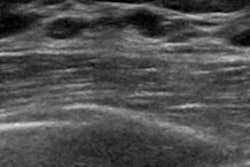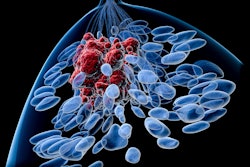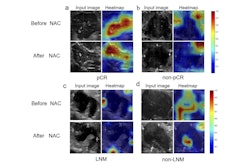A contrast-enhanced ultrasound (CEUS)-based radiomics model could help accurately diagnose breast cancer, suggest findings published November 26 in Clinical Breast Cancer.
Researchers led by Guoqiu Li, MD, from Shenzhen People's Hospital in Guangdong, China, highlighted the high performance of their radiomics model, which incorporated radiomics features from both around (peritumoral) and within (intratumoral) breast tumors on CEUS images.
“The combined model reduced false positives and unnecessary biopsies, outperforming intratumoral-only model,” Li and colleagues wrote.
Radiology researchers continue to explore the potential of CEUS in imaging tumors for more accurate diagnosis of several pathologies. CEUS shows tumor morphology and observes microcirculation, which aids in tumor characterization. However, the researchers noted that the modality is still operator-dependent, meaning objective and quantitative analysis is needed for accurate diagnosis.
Li and co-authors developed the radiomics model by incorporating CEUS-based radiomics features from peritumoral and intratumoral breast tumors. They sought to validate the model for improved breast tumor classification.
The researchers enrolled 333 women with breast lesions between 2022 and 2024. The training set included 144 benign and 55 malignant cases, while the testing set had 97 benign and 37 malignant cases. The researchers also noted that breast cancer was present in 27.6% of patients in both sets (55 in the training set and 37 in the testing set).
The model achieved high predictive accuracy and excellent agreement in Hosmer-Lemeshow testing, the latter of which is statistical testing for goodness of fit and calibration for logistic regression models.
| Performance of CEUS-based radiomics model in breast cancer diagnosis | ||
|---|---|---|
| Measure | Training set | Test set |
| Area under the curve (AUC) | 0.872 | 0.863 |
| Agreement (with 1 as reference) | 0.97 | 0.62 |
Also, decision curve analysis showed that the combined model provided significant clinical benefits across a wide range of threshold probabilities, outperforming the intratumoral model in both sets.
The combined model demonstrated predicted probabilities ranging from 5% to 95%, compared with 10% to 80% for the intratumoral-only model in the training set. In the testing set, the combined model showed significant benefits for predicted probabilities between 5% to 82% and 85% to 95%, compared to 10% to 85% for the intratumoral-only model.
The results highlight the importance of assessing features surrounding breast tumors, the study authors wrote.
“The peritumoral microenvironment is essential in breast cancer progression, as it encompasses critical processes such as angiogenesis, immune cell infiltration, and stromal remodeling, all of which are linked to tumor aggressiveness and metastasis,” they added.
The researchers called for future breast cancer radiomics studies to integrate imaging features from the peritumoral region to better assist clinicians in diagnosing the disease and improving patient outcomes.
The full study can be found here.



















